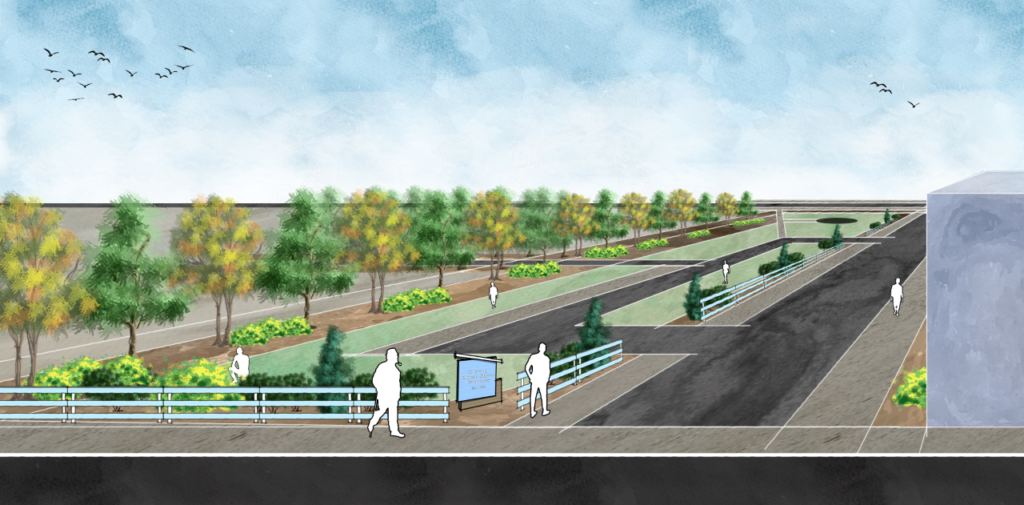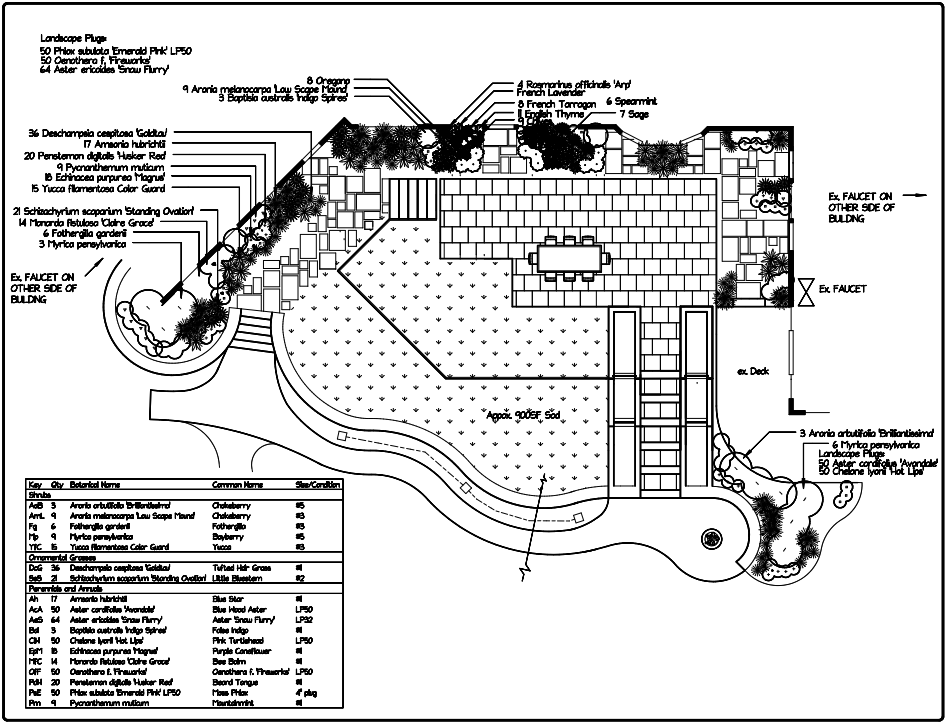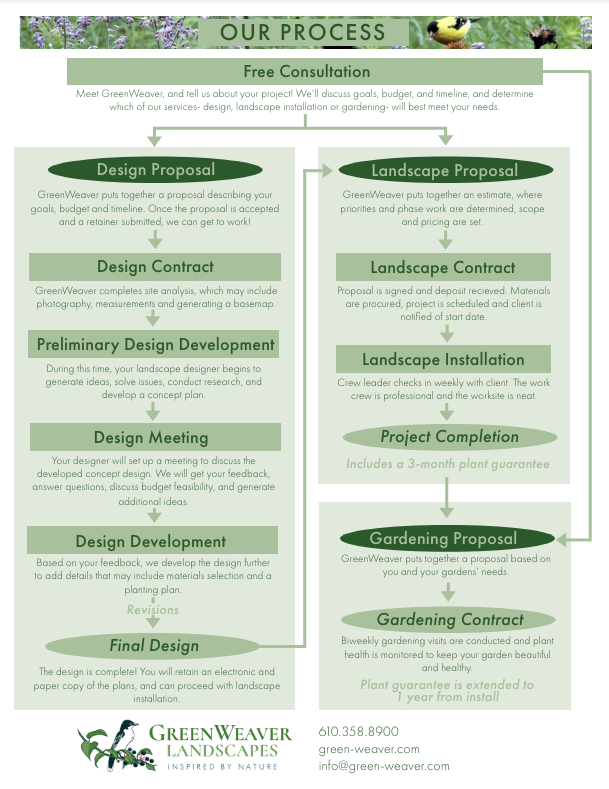Working with a professional landscape designer can be a very rewarding experience. Professional designers can turn your dreams and ideas into reality and may help you avoid costly mistakes in the process. They consider the site, seasonal changes, plant requirements, spacing, wildlife, and your vision, and put it all on paper.
A landscape designer is a professional who can dream up beautiful and highly functional outdoor spaces to meet your needs. Whether you need help designing a foundation planting, an outdoor living space, a storm water basin, or a corporate campus, a landscape designer can show you how to avoid mistakes and maximize the return on your investment.
Do I want a landscape designer or landscape architect?
The scope of your project may determine whether a landscape designer or landscape architect (LA) is needed. Large sites requiring grading plans or large structures usually warrant an LA. Landscape Architects are licensed and registered with the state.
Landscape designers tend to focus more on the medium to small projects. This includes hardscapes such as patios, walks, and outdoor kitchens, with a strong emphasis on the plants.
As in many professions, there are overlaps. Many LAs design residential properties and many landscape designers support large-scale projects.
Selecting a Landscape Designer
The design relationship
Make sure you are comfortable with your landscape designer and trust his or her opinions. Your designer should ask questions and listen to your goals, not just tell you their vision for the property. At the same time, listen to the designer’s advice and expertise. Their experience and training will help you reach your goals in the end.
As in any relationship, communication is important for success. As you work through your project, make sure you are available to answer questions. If possible, everyone involved in making the landscaping decisions should attend the meetings with the designer.
Education, training, and leadership
Ask if your designer is active in their profession. LA’s must take continuing education credits to maintain their licenses, and designers should continue with learning opportunities.
Some excellent designers are self-taught, while others have degrees or formal training in design or horticulture. You should be comfortable with the level of training and experience your designer has received.
Portfolio
Ask to see examples of your designer’s work. Look at their portfolio as examples of the designer’s abilities. See if they have designed projects of similar complexity and scale to what you envision. Also remember, very talented designers may not have an extensive portfolio if they are new to the industry. It takes several years for designs to be implemented, projects to look established, and to get quality photos of the sites.
If this is the case, ask to see sketches or plans that have not been implemented. This will still give you an idea of their capabilities.

The Process
Bring your landscape designer onto your project as early as possible, especially if you’re undergoing major construction. Working with a landscape designer along with your architect or builder allows you to make better decisions along the way. Landscape designers can determine the best locations for walkways, patios, garages or pools, and sometimes even the house! Good design also ensures that beds are wide enough to contain desired plants. Additionally, your designer may help you protect important trees and soils which may be damaged during construction. Many construction considerations will have lasting impacts on your landscape which are best made by landscape professionals.
As you interview designers, get an understanding of how they work. This allows for better communication and sets reasonable expectations throughout your project. Some individual designers and companies have an existing process that they can explain to you. However, if they do not, most designs follow the same basic steps listed below.
Initial Meeting- Determine Goals
You and your designer will discuss and establish your desired goals and preferred style. Share your vision of your site, and your likes and dislikes. Walk around and answer questions about history of the site, water movement, and anything else that may affect the design.
Site Evaluation
Your designer can be most efficient if you have existing base maps or plats of the property. Electronic copies are easiest, but any scaled drawing will save design time. If you do not have a map of your property, your designer can generate a base map for you.
After your designer walks the property with you, they will spend more time on the site assessment. Usually, your designer will spend quite a bit of time walking the site and taking pictures, measurements, and elevations. They may also ask to come into your home to see views from the interior.
Preliminary or Conceptual Design

Your initial plan will include general information noted during the site evaluation and loose conceptual ideas. Major elements like patios, lawns, and plantings are placed in the landscape. Occasionally some specific plants are listed, but it is also common to see areas loosely designated such as “mixed screen” or “cutting garden”. Your designer wants to ensure that you are comfortable with the general concepts during the preliminary design phase.
If you have any concerns or questions, now is the time to voice them. Do not feel like you are being critical of the plan. That is the point of this meeting! Your designer wants your feedback so they can make adjustments and create a design that you love.
Final Design
This plan is a completed plan of your landscape project which includes all design elements. There should be a detailed layout of constructed elements, hardscapes, materials, plants, and bedlines. It should also include a plant schedule with names, sizes, and conditions of plants as well as important information about the site.

Your designer usually presents this in person with an explanation of the intent and how the design meets your goals. Feel free to ask for final adjustments is you still would like to see additional changes, but be aware that there will be design fees associated with each revision. You can also discuss any final questions and next steps.
Determine Phases for Installation
Now it is time to implement the design! Depending on your budget, site conditions, and season, you may not want to install all of the design at one time.
Your designer can help you determine the best ways to proceed in phases. However the work is scheduled, ensure there are enough resources available to maintain the new planting during the critical establishment phase. Generally, this lasts between one and three years, and involves watering and more intense weeding while the new plants fill in the bed.
Costs
Costs and time can vary greatly among landscape designers, which is why it is so important to determine up front that your landscape designer can meet your needs.
Free: At some design-build firms, your landscape design may be included in the cost of the landscape installation. You do not own the design and therefore you cannot “shop around”, nor can you install the project yourself.
Hourly: Rates may range from $25-$150+ per hour: The price ranges are often related to experience or deliverables. A rough hand sketch of your landscape design or an entry-level designer may command the lower end of that range. A principal or senior designer of a firm may charge the upper end of that range. Landscape design/build firms usually fall somewhere in the middle.
Schedule
Allow for a realistic amount of time from when you contact your designer to when you want to finish your landscape project. It can take several weeks for each design phase even when you can accommodate the designer’s schedule and get back to them quickly if they have questions. Once the plan is completed, it will take additional time to generate an estimate, finalize the scope of the project, and sign a contract. Only then can a landscape contractor schedule your project and begin sourcing the materials. It is not unusual to take six months or more from beginning of design to installation.
What happens next?
So you have this awesome plan in your hands and you’re ready to see it come to life. It’s time to select a contractor for the installation and develop a maintenance plan. Your landscape designer may be able to help you with both of these important tasks.
Installation
If your landscape designer is from a design/build firm, they can get you pricing estimates based on the agreed upon design. This ensures that there will be strong communication between the designer and the installation crew, maintaining the initial intent of the design.
Project Management
If your landscape designer comes from a design-only firm, they may recommend contractors they’ve used in the past with successful results. Some designers also work as Project Managers for an additional fee. This may be an hourly rate or may be a percentage of the cost of installation.
Maintenance Plan
Maintenance is the most overlooked part of a landscape installation. And because a landscape is living and ever changing, maintenance is critical to its success.
Your landscape designer is an excellent source for your landscape management plan. For very simple plantings, a verbal explanation of maintenance requirements may suffice. However, installation projects where outside parties will manage the landscape require a well-written plan. This should address regular maintenance as well as how to respond to more serious issues that may arise.
A landscape design is well worth the investment to ensure the maximum function and aesthetic of the site. So start gathering ideas, researching designers, and have some fun! And if you need some inspiration, see a portfolio of our work.


